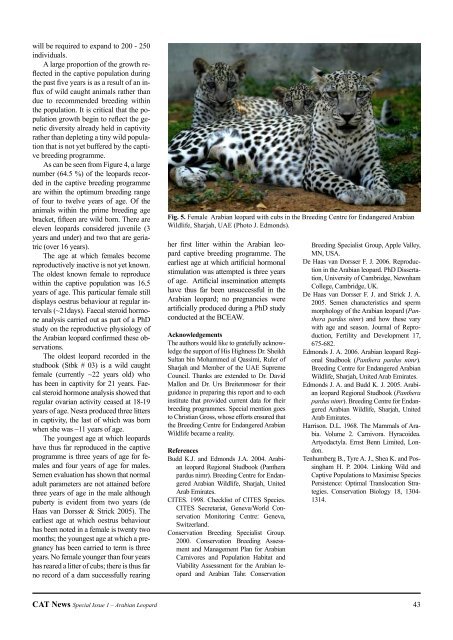Status and Conservation of the Leopard on the ... - Nwrc.gov.sa
Status and Conservation of the Leopard on the ... - Nwrc.gov.sa
Status and Conservation of the Leopard on the ... - Nwrc.gov.sa
Create successful ePaper yourself
Turn your PDF publications into a flip-book with our unique Google optimized e-Paper software.
will be required to exp<str<strong>on</strong>g>and</str<strong>on</strong>g> to 200 - 250<br />
individuals.<br />
A large proporti<strong>on</strong> <str<strong>on</strong>g>of</str<strong>on</strong>g> <str<strong>on</strong>g>the</str<strong>on</strong>g> growth reflected<br />
in <str<strong>on</strong>g>the</str<strong>on</strong>g> captive populati<strong>on</strong> during<br />
<str<strong>on</strong>g>the</str<strong>on</strong>g> past five years is as a result <str<strong>on</strong>g>of</str<strong>on</strong>g> an influx<br />
<str<strong>on</strong>g>of</str<strong>on</strong>g> wild caught animals ra<str<strong>on</strong>g>the</str<strong>on</strong>g>r than<br />
due to recommended breeding within<br />
<str<strong>on</strong>g>the</str<strong>on</strong>g> populati<strong>on</strong>. It is critical that <str<strong>on</strong>g>the</str<strong>on</strong>g> populati<strong>on</strong><br />
growth begin to reflect <str<strong>on</strong>g>the</str<strong>on</strong>g> genetic<br />
diversity already held in captivity<br />
ra<str<strong>on</strong>g>the</str<strong>on</strong>g>r than depleting a tiny wild populati<strong>on</strong><br />
that is not yet buffered by <str<strong>on</strong>g>the</str<strong>on</strong>g> captive<br />
breeding programme.<br />
As can be seen from Figure 4, a large<br />
number (64.5 %) <str<strong>on</strong>g>of</str<strong>on</strong>g> <str<strong>on</strong>g>the</str<strong>on</strong>g> leopards recorded<br />
in <str<strong>on</strong>g>the</str<strong>on</strong>g> captive breeding programme<br />
are within <str<strong>on</strong>g>the</str<strong>on</strong>g> optimum breeding range<br />
<str<strong>on</strong>g>of</str<strong>on</strong>g> four to twelve years <str<strong>on</strong>g>of</str<strong>on</strong>g> age. Of <str<strong>on</strong>g>the</str<strong>on</strong>g><br />
animals within <str<strong>on</strong>g>the</str<strong>on</strong>g> prime breeding age<br />
bracket, fifteen are wild born. There are<br />
eleven leopards c<strong>on</strong>sidered juvenile (3<br />
years <str<strong>on</strong>g>and</str<strong>on</strong>g> under) <str<strong>on</strong>g>and</str<strong>on</strong>g> two that are geriatric<br />
(over 16 years).<br />
The age at which females become<br />
reproductively inactive is not yet known.<br />
The oldest known female to reproduce<br />
within <str<strong>on</strong>g>the</str<strong>on</strong>g> captive populati<strong>on</strong> was 16.5<br />
years <str<strong>on</strong>g>of</str<strong>on</strong>g> age. This particular female still<br />
displays oestrus behaviour at regular intervals<br />
(~21days). Faecal steroid horm<strong>on</strong>e<br />
analysis carried out as part <str<strong>on</strong>g>of</str<strong>on</strong>g> a PhD<br />
study <strong>on</strong> <str<strong>on</strong>g>the</str<strong>on</strong>g> reproductive physiology <str<strong>on</strong>g>of</str<strong>on</strong>g><br />
<str<strong>on</strong>g>the</str<strong>on</strong>g> Arabian leopard c<strong>on</strong>firmed <str<strong>on</strong>g>the</str<strong>on</strong>g>se observati<strong>on</strong>s.<br />
The oldest leopard recorded in <str<strong>on</strong>g>the</str<strong>on</strong>g><br />
studbook (Stbk # 03) is a wild caught<br />
female (currently ~22 years old) who<br />
has been in captivity for 21 years. Faecal<br />
steroid horm<strong>on</strong>e analysis showed that<br />
regular ovarian activity ceased at 18-19<br />
years <str<strong>on</strong>g>of</str<strong>on</strong>g> age. Nesra produced three litters<br />
in captivity, <str<strong>on</strong>g>the</str<strong>on</strong>g> last <str<strong>on</strong>g>of</str<strong>on</strong>g> which was born<br />
when she was ~11 years <str<strong>on</strong>g>of</str<strong>on</strong>g> age.<br />
The youngest age at which leopards<br />
have thus far reproduced in <str<strong>on</strong>g>the</str<strong>on</strong>g> captive<br />
programme is three years <str<strong>on</strong>g>of</str<strong>on</strong>g> age for females<br />
<str<strong>on</strong>g>and</str<strong>on</strong>g> four years <str<strong>on</strong>g>of</str<strong>on</strong>g> age for males.<br />
Semen evaluati<strong>on</strong> has shown that normal<br />
adult parameters are not attained before<br />
three years <str<strong>on</strong>g>of</str<strong>on</strong>g> age in <str<strong>on</strong>g>the</str<strong>on</strong>g> male although<br />
puberty is evident from two years (de<br />
Haas van Dorsser & Strick 2005). The<br />
earliest age at which oestrus behaviour<br />
has been noted in a female is twenty two<br />
m<strong>on</strong>ths; <str<strong>on</strong>g>the</str<strong>on</strong>g> youngest age at which a pregnancy<br />
has been carried to term is three<br />
years. No female younger than four years<br />
has reared a litter <str<strong>on</strong>g>of</str<strong>on</strong>g> cubs; <str<strong>on</strong>g>the</str<strong>on</strong>g>re is thus far<br />
no record <str<strong>on</strong>g>of</str<strong>on</strong>g> a dam successfully rearing<br />
Fig. 5. Female Arabian leopard with cubs in <str<strong>on</strong>g>the</str<strong>on</strong>g> Breeding Centre for Endangered Arabian<br />
Wildlife, Sharjah, UAE (Photo J. Edm<strong>on</strong>ds).<br />
her first litter within <str<strong>on</strong>g>the</str<strong>on</strong>g> Arabian leopard<br />
captive breeding programme. The<br />
earliest age at which artificial horm<strong>on</strong>al<br />
stimulati<strong>on</strong> was attempted is three years<br />
<str<strong>on</strong>g>of</str<strong>on</strong>g> age. Artificial inseminati<strong>on</strong> attempts<br />
have thus far been unsuccessful in <str<strong>on</strong>g>the</str<strong>on</strong>g><br />
Arabian leopard; no pregnancies were<br />
artificially produced during a PhD study<br />
c<strong>on</strong>ducted at <str<strong>on</strong>g>the</str<strong>on</strong>g> BCEAW.<br />
Acknowledgements<br />
The authors would like to gratefully acknowledge<br />
<str<strong>on</strong>g>the</str<strong>on</strong>g> support <str<strong>on</strong>g>of</str<strong>on</strong>g> His Highness Dr. Sheikh<br />
Sultan bin Mohammed al Qassimi, Ruler <str<strong>on</strong>g>of</str<strong>on</strong>g><br />
Sharjah <str<strong>on</strong>g>and</str<strong>on</strong>g> Member <str<strong>on</strong>g>of</str<strong>on</strong>g> <str<strong>on</strong>g>the</str<strong>on</strong>g> UAE Supreme<br />
Council. Thanks are extended to Dr. David<br />
Mall<strong>on</strong> <str<strong>on</strong>g>and</str<strong>on</strong>g> Dr. Urs Breitenmoser for <str<strong>on</strong>g>the</str<strong>on</strong>g>ir<br />
guidance in preparing this report <str<strong>on</strong>g>and</str<strong>on</strong>g> to each<br />
institute that provided current data for <str<strong>on</strong>g>the</str<strong>on</strong>g>ir<br />
breeding programmes. Special menti<strong>on</strong> goes<br />
to Christian Gross, whose efforts ensured that<br />
<str<strong>on</strong>g>the</str<strong>on</strong>g> Breeding Centre for Endangered Arabian<br />
Wildlife became a reality.<br />
References<br />
Budd K.J. <str<strong>on</strong>g>and</str<strong>on</strong>g> Edm<strong>on</strong>ds J.A. 2004. Arabian<br />
leopard Regi<strong>on</strong>al Studbook (Pan<str<strong>on</strong>g>the</str<strong>on</strong>g>ra<br />
pardus nimr). Breeding Centre for Endangered<br />
Arabian Wildlife, Sharjah, United<br />
Arab Emirates.<br />
CITES. 1998. Checklist <str<strong>on</strong>g>of</str<strong>on</strong>g> CITES Species.<br />
CITES Secretariat, Geneva/World <str<strong>on</strong>g>C<strong>on</strong>servati<strong>on</strong></str<strong>on</strong>g><br />
M<strong>on</strong>itoring Centre: Geneva,<br />
Switzerl<str<strong>on</strong>g>and</str<strong>on</strong>g>.<br />
<str<strong>on</strong>g>C<strong>on</strong>servati<strong>on</strong></str<strong>on</strong>g> Breeding Specialist Group.<br />
2000. <str<strong>on</strong>g>C<strong>on</strong>servati<strong>on</strong></str<strong>on</strong>g> Breeding Assessment<br />
<str<strong>on</strong>g>and</str<strong>on</strong>g> Management Plan for Arabian<br />
Carnivores <str<strong>on</strong>g>and</str<strong>on</strong>g> Populati<strong>on</strong> Habitat <str<strong>on</strong>g>and</str<strong>on</strong>g><br />
Viability Assessment for <str<strong>on</strong>g>the</str<strong>on</strong>g> Arabian leopard<br />
<str<strong>on</strong>g>and</str<strong>on</strong>g> Arabian Tahr. <str<strong>on</strong>g>C<strong>on</strong>servati<strong>on</strong></str<strong>on</strong>g><br />
Breeding Specialist Group, Apple Valley,<br />
MN, USA.<br />
De Haas van Dorsser F. J. 2006. Reproducti<strong>on</strong><br />
in <str<strong>on</strong>g>the</str<strong>on</strong>g> Arabian leopard. PhD Dissertati<strong>on</strong>,<br />
University <str<strong>on</strong>g>of</str<strong>on</strong>g> Cambridge, Newnham<br />
College, Cambridge, UK.<br />
De Haas van Dorsser F. J. <str<strong>on</strong>g>and</str<strong>on</strong>g> Strick J. A.<br />
2005. Semen characteristics <str<strong>on</strong>g>and</str<strong>on</strong>g> sperm<br />
morphology <str<strong>on</strong>g>of</str<strong>on</strong>g> <str<strong>on</strong>g>the</str<strong>on</strong>g> Arabian leopard (Pan<str<strong>on</strong>g>the</str<strong>on</strong>g>ra<br />
pardus nimr) <str<strong>on</strong>g>and</str<strong>on</strong>g> how <str<strong>on</strong>g>the</str<strong>on</strong>g>se vary<br />
with age <str<strong>on</strong>g>and</str<strong>on</strong>g> seas<strong>on</strong>. Journal <str<strong>on</strong>g>of</str<strong>on</strong>g> Reproducti<strong>on</strong>,<br />
Fertility <str<strong>on</strong>g>and</str<strong>on</strong>g> Development 17,<br />
675-682.<br />
Edm<strong>on</strong>ds J. A. 2006. Arabian leopard Regi<strong>on</strong>al<br />
Studbook (Pan<str<strong>on</strong>g>the</str<strong>on</strong>g>ra pardus nimr).<br />
Breeding Centre for Endangered Arabian<br />
Wildlife, Sharjah, United Arab Emirates.<br />
Edm<strong>on</strong>ds J. A. <str<strong>on</strong>g>and</str<strong>on</strong>g> Budd K. J. 2005. Arabian<br />
leopard Regi<strong>on</strong>al Studbook (Pan<str<strong>on</strong>g>the</str<strong>on</strong>g>ra<br />
pardus nimr). Breeding Centre for Endangered<br />
Arabian Wildlife, Sharjah, United<br />
Arab Emirates.<br />
Harris<strong>on</strong>. D.L. 1968. The Mammals <str<strong>on</strong>g>of</str<strong>on</strong>g> Arabia.<br />
Volume 2. Carnivora. Hyracoidea.<br />
Artyodactyla. Ernst Benn Limited, L<strong>on</strong>d<strong>on</strong>.<br />
Tenhumberg B., Tyre A. J., Shea K. <str<strong>on</strong>g>and</str<strong>on</strong>g> Possingham<br />
H. P. 2004. Linking Wild <str<strong>on</strong>g>and</str<strong>on</strong>g><br />
Captive Populati<strong>on</strong>s to Maximise Species<br />
Persistence: Optimal Translocati<strong>on</strong> Strategies.<br />
<str<strong>on</strong>g>C<strong>on</strong>servati<strong>on</strong></str<strong>on</strong>g> Biology 18, 1304-<br />
1314.<br />
CAT News Special Issue 1 – Arabian <str<strong>on</strong>g>Leopard</str<strong>on</strong>g> 43
















